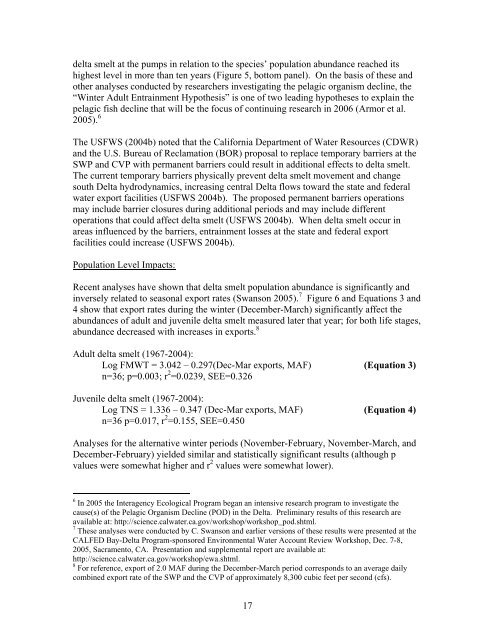ESWR page - Endangered Species & Wetlands Report
ESWR page - Endangered Species & Wetlands Report
ESWR page - Endangered Species & Wetlands Report
Create successful ePaper yourself
Turn your PDF publications into a flip-book with our unique Google optimized e-Paper software.
delta smelt at the pumps in relation to the species’ population abundance reached its<br />
highest level in more than ten years (Figure 5, bottom panel). On the basis of these and<br />
other analyses conducted by researchers investigating the pelagic organism decline, the<br />
“Winter Adult Entrainment Hypothesis” is one of two leading hypotheses to explain the<br />
pelagic fish decline that will be the focus of continuing research in 2006 (Armor et al.<br />
2005). 6<br />
The USFWS (2004b) noted that the California Department of Water Resources (CDWR)<br />
and the U.S. Bureau of Reclamation (BOR) proposal to replace temporary barriers at the<br />
SWP and CVP with permanent barriers could result in additional effects to delta smelt.<br />
The current temporary barriers physically prevent delta smelt movement and change<br />
south Delta hydrodynamics, increasing central Delta flows toward the state and federal<br />
water export facilities (USFWS 2004b). The proposed permanent barriers operations<br />
may include barrier closures during additional periods and may include different<br />
operations that could affect delta smelt (USFWS 2004b). When delta smelt occur in<br />
areas influenced by the barriers, entrainment losses at the state and federal export<br />
facilities could increase (USFWS 2004b).<br />
Population Level Impacts:<br />
Recent analyses have shown that delta smelt population abundance is significantly and<br />
inversely related to seasonal export rates (Swanson 2005). 7 Figure 6 and Equations 3 and<br />
4 show that export rates during the winter (December-March) significantly affect the<br />
abundances of adult and juvenile delta smelt measured later that year; for both life stages,<br />
abundance decreased with increases in exports. 8<br />
Adult delta smelt (1967-2004):<br />
Log FMWT = 3.042 – 0.297(Dec-Mar exports, MAF) (Equation 3)<br />
n=36; p=0.003; r 2 =0.0239, SEE=0.326<br />
Juvenile delta smelt (1967-2004):<br />
Log TNS = 1.336 – 0.347 (Dec-Mar exports, MAF) (Equation 4)<br />
n=36 p=0.017, r 2 =0.155, SEE=0.450<br />
Analyses for the alternative winter periods (November-February, November-March, and<br />
December-February) yielded similar and statistically significant results (although p<br />
values were somewhat higher and r 2 values were somewhat lower).<br />
6 In 2005 the Interagency Ecological Program began an intensive research program to investigate the<br />
cause(s) of the Pelagic Organism Decline (POD) in the Delta. Preliminary results of this research are<br />
available at: http://science.calwater.ca.gov/workshop/workshop_pod.shtml.<br />
7 These analyses were conducted by C. Swanson and earlier versions of these results were presented at the<br />
CALFED Bay-Delta Program-sponsored Environmental Water Account Review Workshop, Dec. 7-8,<br />
2005, Sacramento, CA. Presentation and supplemental report are available at:<br />
http://science.calwater.ca.gov/workshop/ewa.shtml.<br />
8 For reference, export of 2.0 MAF during the December-March period corresponds to an average daily<br />
combined export rate of the SWP and the CVP of approximately 8,300 cubic feet per second (cfs).<br />
17
















